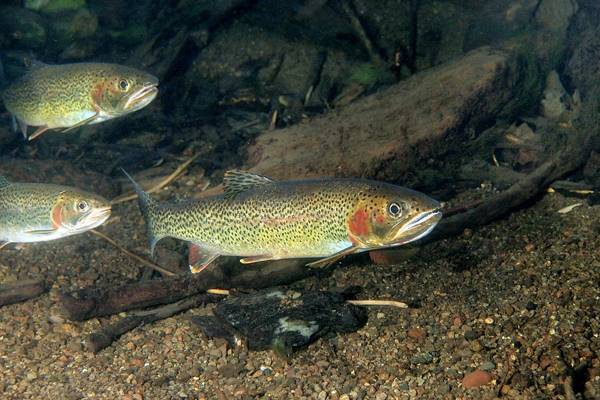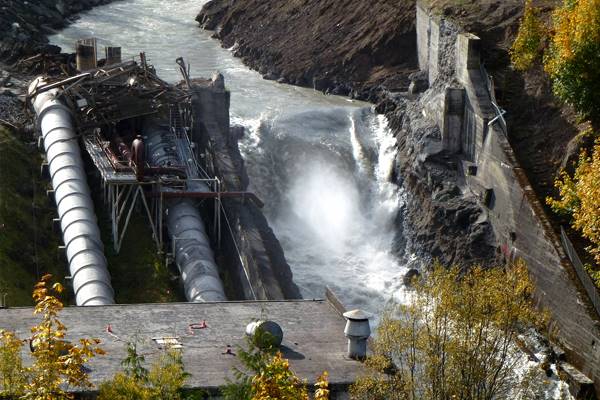Rare fall-spawning coastal cutthroat in Elwha River watershed might not last after dam removal
In the Elwha River watershed, where the largest dam removal in history is winding down, biologists have documented some strange behavior in an isolated group of coastal cutthroat trout. In a tributary above the former dam sites, the cutthroats were found spawning in a different season than the rest of the subspecies, including other coastal cutthroats swimming in the same creek just a few miles downstream. Most coastal cutthroats spawn in the spring.
“That is really rare, at that small of a scale, to see that big of a difference in spawn timing for a species,” said John McMillan, who led a study of these fall-spawning coastal cutthroats in Indian Creek that was recently published in the journal Transactions of the American Fisheries Society.
Separate spawning seasons among a single trout subspecies might come off as inside baseball to even the most angling-oriented public, but it’s the sort of thing that makes a fish biologist like McMillan utter some version of “This is really cool” upwards of five times in a 20-minute interview. And to add a twist of drama, it’s not clear how much longer this unique spawning strategy will persist. The recent removal of two dams on the Elwha opened up the upper river and its tributaries — including Indian Creek — to sea-run salmon and steelhead for the first time in more than 100 years. Coho salmon spawn at the same time as these isolated, off-schedule cutthroats, and if the brawnier salmon take advantage of their new access to Indian Creek, the smaller trout may be lost in the bustle.
McMillan first heard about the fall-spawning cutthroats as a NOAA research fishery biologist working on the Elwha dam removal project, which brought down the towering, fish-blocking Elwha and Glines Canyon dams to great fanfare from wild salmon advocates. Michael McHenry, a fisheries habitat biologist with the Lower Elwha Klallam Tribe and co-author on the study, told McMillan he saw the cutthroats spawning at an unexpected time. McMillan was excited to look into a unique aspect of a fish loves to study — and to fish for.
Late one October, he headed up to a short stretch of Indian Creek between its source at Lake Sutherland and a large beaver pond. “It looks like a little Alaska,” he recalled. “Hundreds, hundreds of these cutthroat — probably thousands, actually — in there spawning.”

Coastal cutthroat swim in Indian Creek, where they unusually spawn in the fall. (Credit: John McMillan)
In 2013 and 2014, he and his colleagues counted redds and surveyed the fish by foot and by snorkel to pin down their spawning season, finding that it tends to start around mid-October and wrap up by the first or second week of November. Not only is that months off from the February-to-May spawning season standard for most coastal cutthroats, it’s also a much shorter season.
So what’s going on here? Fall marks the beginning of the rainy season on the Olympic Peninsula, where the mountains trap moist air blowing in from the Pacific and wring out rainfall totals that make the peninsula one of the wettest places in the Lower 48. It’s not uncommon for 5 inches of rain to fall in 24 hours, taking a river flowing at 100 cubic feet per second and pumping it up to 50,000 cfs, McMillan said. That’s certainly enough to wipe a little trout-dug redd off the riverbed, so trout tend to spawn in the spring when things have calmed down.
But Indian Creek flows from Lake Sutherland, which appears to capture enough rainfall to stabilize flows in the upper creek where the fall-spawning cutthroat live. “Rivers that come out of lakes are kind of like tailrace fisheries behind dams,” McMillan said. “They don’t flood very much.” That leaves the redds intact, while the groundwater-fed lake also stabilizes the upper creek’s temperatures, keeping them closer to ideal spawning conditions.
But in the lower creek, downstream of the beaver pond, the stabilizing effect appears to wain. The watershed funnels more rainfall into the creek and the flows are more variable. The coastal cutthroats down there, just a few miles away, spawn in the spring.

After the removal of the Elwha Dam, shown here, and the Glines Canyon Dam, coho salmon might swim up Indian Creek and disrupt the fall-spawning coastal cutthroats. (Credit: Kate Benkert/USFWS)
That’s particularly interesting because unique spawning habits — whether separated by time or physical barriers — is part of what goes into determining just what makes up a new species or subspecies.
“Isolation is absolutely a key to developing a new type of subspecies,” McMillan said, adding that future research on these cutthroats could look for genetic differences between those in the upper and lower creek. “And we would expect there to be.”
The other research question remaining is whether coho salmon — no longer blocked by the Elwha and Glines Canyon dams and already colonizing Indian Creek — will leave any room on the riverbed for their fellow fall spawners.
“We’ve got a really unique life history here,” said McMillan, who recently took up a new post as science director for Trout Unlimited’s Wild Steelhead Initiative. “In the future, is that life history going to be able to maintain itself if these coho come in and essentially re-excavate all those cutthroat redds?”
It’s very possible, he said, but time will tell. “So far there has been very little overlap in spawning among the two species, but it is increasing,” he said.



0 comments